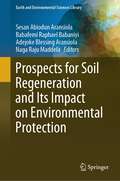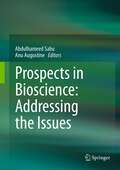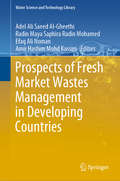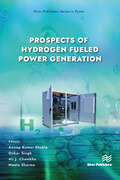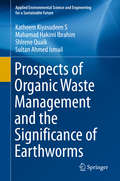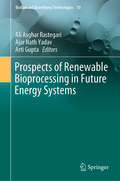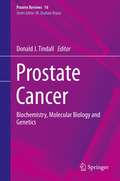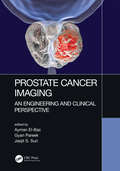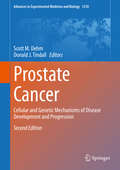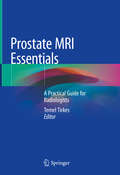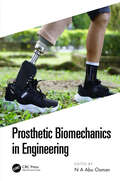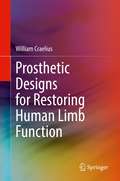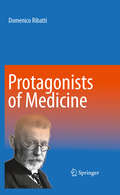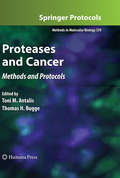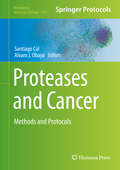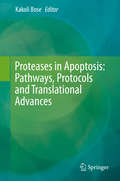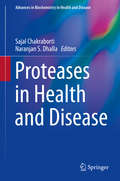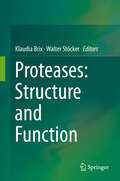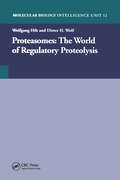- Table View
- List View
Prospects for Soil Regeneration and Its Impact on Environmental Protection (Earth and Environmental Sciences Library)
by Naga Raju Maddela Sesan Abiodun Aransiola Babafemi Raphael Babaniyi Adejoke Blessing AransiolaSoil is a complex system of inorganic and organic materials, living organisms, water, and air. It is home to more than one trillion species of microorganisms. Soil also plays an important role in the global carbon cycle. Because plants absorb carbon from the atmosphere, convert it to plant tissue, and return it to the soil as plant residue, soils globally act as the world’s largest sink of active carbon. Soil has role to play in food production and safety. Soil contamination undermined by modern agricultural practices that deplete soil carbon stocks. Anthropogenic greenhouse gas emissions have been raising recorded temperatures since the Industrial Revolution. Greenhouse gas emissions from agriculture, forestry, and fisheries have almost doubled in the last 50 years and will increase by 30% by 2050 given the current trend. The primacy of arresting climate change is nowhere more evident than the adoption of 195 countries of the first legally binding global climate deal at the Paris Climate Conference in 2015. With atmospheric carbon dioxide (CO2) reaching 400 parts per million in 2016, soils can be an ally in bringing the CO2 level down to a sustainable level if protected for regeneration. Soil protection and regeneration is a technique that involves the conservative rehabilitation of soil ecosystem and farmland. This technique focuses on top soil regeneration, improving the water cycle, supporting biosequestration, enhancing ecosystem services, increasing biodiversity, strengthening the vitality and health of farm soil, and increasing resilience to climate change and landscape. Environmental protection not only improves soil health, productivity, and resilience to weather extremes, raising farm yields and income while strengthening regional food security in the face of a changing climate, but can also form part of a region’s broader climate strategy. This book is timely as more studies and reviews need to be reported about regenerating global polluted soil and the impacts on the environment, the benefit of both biotic and abiotic structure, thereby creating more awareness of environmental protection and sustainability. Thus, this book presents a vista to research on regeneration of lost resources in the soil and its impacts on the environment.
Prospects in Bioscience: Addressing the Issues
by Abdulhameed Sabu Anu AugustineThe book entitled "Prospects in Bioscience: Addressing the issues" is a collection of selected research papers presented at the International Conference on Advances in Biological Sciences (ICABS) organized by the Department of Biotechnology and Microbiology and the Inter University Centre for Bioscience, Kannur University, Kerala, India. ICABS witnessed a unique spectrum of Scientific Programmes on the most recent and exciting developments in modern biology. The conference displayed the numerous breakthroughs and significant developments in the important areas of modern biology and their relevance to the welfare of global society. The Book contains 50 well written chapters, each one discussing scientifically organized findings of original research work done in reputed laboratories. Needless to say, they deal with advances in various disciplines of modern biology including Cell and Molecular Biology, Structural Biology, Industrial and Environmental Biotechnology, Food and Agricultural Biotechnology and Medical Biotechnology. As the title rightly indicates, the chapters project the prospects in the respective areas and the issues in them. Specific issues discussed in the book includes development of transgenic plants, bioremediation of toxic industrial effluents, biotransformation for novel antibiotics, biofertilizer development, molecular drug designing and structure elucidation, molecular identification of pathogens, production of anti microbials, biocontrol agents and bioactive molecules, cancer biology, plant breeding and hybrid seed production etc. The book with its contents spreading across the vast arena of modern biology is expected to cater to the need of researchers, technologists and students.
Prospects of Artificial Intelligence in the Environment
by Ajitanshu Vedrtnam Kevin P. Wyche Balendra V. Chauhan Sneha VermaThis book gives readers insight into the state-of-the-art use of artificial intelligence for the environment. It encompasses most of the significant facets of current breakthroughs in the fields of conceptions, methodologies, resources, and leading artificial intelligence solutions for the environment. This book presents research at the forefront on applications of artificial intelligence in combating climate change, natural hazards, and textile dyeing pollution (water pollution), for forecasting, assessing air quality trends, and air pollution monitoring. It explains how machine learning can prove to be an efficient technique to forecast the consumption of energy and how AI can be effective for renewable energy systems. Research in this book widens its scope to present the problems, opportunities, and directives for the application of AI systems in engine exhaust prediction. One of the new and interesting things explored is to provide and predict the rate of decay of human lung tissue (due to Particulate Matter exposure) with the help of AI in this book. Likewise, the book opens its scope to various environmental problems and focuses on giving the best solutions with an application of artificial intelligence; this feature makes this book an indispensable guide for environmental scientists and AI researchers of all levels. The book is written comprehensively so that engineering professionals, programmers, environmentalists, graduates, postgraduates, and researchers from beginning/intermediate level to advance level can be enlightened.
Prospects of Fresh Market Wastes Management in Developing Countries (Water Science and Technology Library #92)
by Radin Maya Saphira Radin Mohamed Adel Ali Saeed Al-Gheethi Amir Hashim Mohd Kassim Efaq Ali NomanThis book focuses on the prospects of fresh market waste management in developing countries. It characterizes fresh market wastewater and solid wastes, and highlights the human health impact of corresponding waste management practices. With regard to treatment technologies, the book discusses the anaerobic digestion of fresh solid wastes; the application of natural coagulants for wastewater treatment; the remediation of xenobiotics in wastewater using nanotechnology; and biofilter aquaponic systems for nutrient removal. All of these technologies are recent innovations, offer several concrete advantages, and can be applied in developing countries as non-central treatment systems. In addition, the book covers electricity production from fresh solid wastes using microbial fuel cells, demonstrating the potential held by recycling fresh market wastewater and solid wastes.
Prospects of Hydrogen Fueled Power Generation (River Publishers Series in Power)
by Anoop Kumar Shukla Onkar Singh Meeta Sharma Ali J. ChamkhaProspects of Hydrogen-fueled Power Generation brings together experts to explore the various challenges and opportunities of hydrogen as a fuel in power generation, transportation, storage, and safety. Special interest is given to proton exchange membrane fuel cell (PEMFC) fuel cells, hydrogen energy, and the conversion methods. The usage of clean fuel in road transportation, marine transportation, and the power generation sector are also discussed in detail. Additionally, performance investigations reveal information about the system's energy and exergy analysis.Hydrogen-fueled power generation is the process of generating electricity using hydrogen as the primary fuel source. This process typically involves the conversion of hydrogen into electricity using fuel cells or combustion engines. Fuel cells are electrochemical devices that convert hydrogen into electricity and water with no emissions other than water vapor. Combustion engines, on the other hand, burn hydrogen to produce heat, which is used to generate electricity through a turbine. The byproducts of hydrogen combustion are water and heat, with no harmful emissions. One advantage of hydrogen-fueled power generation is that it produces no harmful emissions, making it a clean and sustainable source of energy. Additionally, hydrogen is a highly abundant element that can be produced from a variety of sources, including natural gas, biomass, and renewable energy sources like solar and wind power.
Prospects of Organic Waste Management and the Significance of Earthworms
by Katheem Kiyasudeen S Mahamad Hakimi Ibrahim Shlrene Quaik Sultan Ahmed IsmailThe main aim of this book is to bridge the gap between aerobic and anaerobic waste treatments by concentrating on studies of earthworms. In particular, vermicomposting is being discussed as well as its properties and applications. Other subjects touch on the treatment of palm oil mill effluents, the various importance of earthworms, its scope and future aspects of earthworm research, and the impact of waste management practices on human health.
Prospects of Renewable Bioprocessing in Future Energy Systems (Biofuel and Biorefinery Technologies #10)
by Ajar Nath Yadav Arti Gupta Ali Asghar RastegariThis book discusses various renewable energy resources and technologies. Topics covered include recent advances in photobioreactor design; microalgal biomass harvesting, drying, and processing; and technological advances and optimised production systems as prerequisites for achieving a positive energy balance. It highlights alternative resources that can be used to replace fossil fuels, such as algal biofuels, biodiesel, bioethanol, and biohydrogen. Further, it reviews microbial technologies, discusses an immobilization method, and highlights the efficiency of enzymes as a key factor in biofuel production. In closing, the book outlines future research directions to increase oil yields in microalgae, which could create new opportunities for lipid-based biofuels, and provides an outlook on the future of global biofuel production. Given its scope, the book will appeal to all researchers and engineers working in the renewable energy sector.
Prospero's America
by Walter W. WoodwardIn Prospero's America, Walter W. Woodward examines the transfer of alchemical culture to America by John Winthrop, Jr., one of English colonization's early giants. Winthrop participated in a pan-European network of natural philosophers who believed alchemy could improve the human condition and hasten Christ's Second Coming. Woodward demonstrates the influence of Winthrop and his philosophy on New England's cultural formation: its settlement, economy, religious toleration, Indian relations, medical practice, witchcraft prosecution, and imperial diplomacy. Prospero's America reconceptualizes the significance of early modern science in shaping New England hand in hand with Puritanism and politics.
Prostate Cancer
by Donald J. TindallProstate Cancer provides an up to date review of the biochemistry, molecular biology, and genetic changes in prostate cells that are the driving forces in the initiation and progression of cancer. It includes an overview by experts in the field of cell-cell interactions, including stem cells, reactive Stromal cells and membrane lipid rafts that are instrumental in the initiation and progression of prostate cancer.
Prostate Cancer Imaging: An Engineering and Clinical Perspective
by Jasjit Suri Ayman El-Baz Gyan PareekThis book covers novel strategies and state of the art approaches for automated non-invasive systems for early prostate cancer diagnosis. Prostate cancer is the most frequently diagnosed malignancy after skin cancer and the second leading cause of cancer related male deaths in the USA after lung cancer. However, early detection of prostate cancer increases chances of patients’ survival. Generally, The CAD systems analyze the prostate images in three steps: (i) prostate segmentation; (ii) Prostate description or feature extraction; and (iii) classification of the prostate status. Explores all of the latest research and developments in state-of-the art imaging of the prostate from world class experts. Contains a comprehensive overview of 2D/3D Shape Modeling for MRI data. Presents a detailed examination of automated segmentation of the prostate in 3D imaging. Examines Computer-Aided-Diagnosis through automated techniques. There will be extensive references at the end of each chapter to enhance further study.
Prostate Cancer: Advancements in the Pathogenesis, Diagnosis and Personalized Therapy
by Gordana Kocic Jovan Hadzi-Djokic Tatjana SimicThis book provides an in-depth exploration of the biology of prostate cancer, from its cellular origins to its clinical manifestations and therapeutic options. In addition to thoroughly covering a variety of diagnostic methods, radical procedures, radiation therapy, hormone therapy, and surgical techniques for prostatectomy, the book seeks to improve the understanding of the development of prostate cancer. Delving into the latest research and scientific advancements, the book starts by shedding light on the critical role of genetic susceptibility, redox signaling, apoptosis, epigenomics, transcriptomics, and metabolic reprogramming in prostate cancer development and progression. In the following section key concepts in prostate cancer diagnostics are covered. This includes the diagnostic, prognostic, and theranostic potential of miRNAs in prostate cancer; the necessity of biopsy; and the importance of histopathological and molecular markers in assessing aggressivity. It alsoexplores recent advances in tumor markers for early detection and monitoring, as well as biological markers of therapeutic response. The book concludes by offering a wealth of knowledge on current treatment options for prostate cancer, including surgical treatments, hormone therapy for advanced cases, the use of apheresis in personalized cell-mediated treatment, pharmacogenomics and precision therapy challenges and perspectives, stereotactic radiotherapy, and treatment for castration-resistant prostate cancer. Scientists and medical professionals interested in basic and clinical research in urology and oncology will find this book to be a useful reference. It is a helpful tool for preparing medical specialization in pathology, oncology, urology, clinical biochemistry, laboratory medicine, diagnostic radiology, oncologic radiology, and related fields of cancer research. With its integrative approach to diagnostics and focus on recent scientific breakthroughs, this book empowers readers to deepen their understanding of prostate cancer and enhance their ability to advance basic and clinical research to treat this pervasive disease.
Prostate Cancer: Cellular and Genetic Mechanisms of Disease Development and Progression (Advances in Experimental Medicine and Biology #1210)
by Donald J. Tindall Scott M. DehmThe purpose of this book is to provide a contemporary overview of the causes and consequences of prostate cancer from a cellular and genetic perspective. Written by experts in the fields of epidemiology, toxicology, cell biology, genetics, genomics, cell-cell interactions, cell signaling, hormone signaling, and transcriptional regulation, the text covers aspects of prostate cancer from disease initiation to metastasis.Chapters explore in depth the cells of origin for prostate cancer, its genomic subtypes, neural transcription factors in disease progression, epigenetic regulation of chromatin, and many other topics. This book distinguishes itself from other texts on prostate cancer by its focus on cellular and genetic mechanisms, as opposed to clinical diagnosis and management. As a result, this book will be of broad interest to basic and translational scientists with familiarity of these topics, as well as to trainees at earlier stages of their research careers.
Prostate MRI Essentials: A Practical Guide for Radiologists
by Temel TirkesThis book is a basic, practical guide to performing and interpreting state-of-the-art prostate MRI, utilizing the latest guidelines in the field. Prostate MRI has become one of the fastest growing examinations in the radiology practice, and this demand has continuously increased within the past decade. Since it is relatively new, MRI of the prostate is predominantly being performed at academic institutions, however there is a growing demand within the lower-tier health care institutions to offer this examination to their patients. This is an ideal guide for radiologists who want to enhance or initiate prostate MRI service for their referring clinicians and as a manual for technologists and those who are in training. Prostate cancer is the second leading cause of cancer death in men, exceeded only by lung cancer. The best predictor of disease outcome lies with correct diagnosis, which requires precise imaging and diagnostic procedures aided by prostate MRI. Urologists, medical oncologists and radiation oncologists all agree that multi-parametric prostate MRI is essential for evaluation of prostate cancer. However, the technical aspects of prostate MR imaging are not as straightforward as for the other imaging modalities and constantly evolving. Its small size presents a real challenge to the radiologist, who needs to do the T2 and diffusion weighted images and perform a dynamic contrast enhanced sequence correctly. These images may also need to be analyzed on an independent workstation. Due to the absence of a current reference manual, when a radiologist wants to establish a prostate imaging service, he/she needs to attend dedicated prostate MR workshops or dive into the literature search alone, only to get more confused about what to do and how to do it. With this book, expert authors were asked to give clear guidance to those who want to enhance or initiate their prostate imaging service. With this much-needed, concise, practical guidance, radiologists can perform and interpret multi-parametric prostate MRI in a standardized fashion, in concordance with PI-RADS v2.1 that can be applicable to all available hardware platforms (GE, Philips, Siemens, Toshiba). Additionally, they can perform post-processing for possible targeted biopsy and interpret post-therapy and PET studies. The book discusses imaging protocols (planning and prescription) and sequence parameters with representative images for each MRI sequence. This handbook-style practical manual can be used in the radiology reading room by those interpreting the MR exam as a reference as well as at the MRI scanner by the technologists as a guide. Coverage of basic prostate anatomy, pathology, Urologists’ point of view, MRI guided radiation treatment planning and molecular imaging is also included. Throughout the book, authors will discuss basics, pitfalls, and provide tips in image acquisition and interpretation, alongside several case examples.
Prosthetic Biomechanics in Engineering
by Osman AbuProsthetic biomechanics is an interdisciplinary field of engineering, medicine, and biology, focused on enhancing people’s lifestyles. In the past 20 years, the field of prosthetic biomechanics and its potential have grown due to the support of advances in engineering technologies. Prosthetic Biomechanics in Engineering is about the recent advances in prosthetic engineering research. The scope of the book is focused on the design, development, and evaluation of a prosthetic systems that are being used in biomechanical applications. The book covers advanced materials, conceptual design, classification, ergonomics design applications, brain computer interface (BCI) system, motion analysis, postural stand stability, upper and lower limb prosthetics, types of suspension systems for prosthetics, Fiber Bragg Grating-based techniques, and pressure on the residual limb and the socket. The early chapters effectively describe new sensors for in-socket systems, new pylon material, and advanced gait analysis. Further chapters discuss advanced techniques for the design and development of prosthetics based on clinical and emergency uses. The information provided in this book is intended for researchers and investigators to encourage further advances in the field of prosthetics research, and for the development of rehabilitation equipment for the improvement of human health, and it: Presents recent advances in prosthetic biomechanics engineering research Discusses the design and development of limb prosthetic systems Explores advanced concepts of the prosthetic sockets Describes gait analysis of prosthetics and orthotics Dr Noor Azuan Abu Osman is a practicing engineer and Professor of Biomechanics with Department of Biomedical Engineering, Faculty of Engineering, University of Malaya, Malaysia.
Prosthetic Designs for Restoring Human Limb Function
by William CraeliusThis textbook provides a thorough introduction and overview of the design and engineering of state-of-the-art prosthetics and assistive technologies. Innovations in prosthetics are increasingly made by cross-disciplinary thinking, and the author introduces the application of biomedical, mechanical, electrical, computer, and materials engineering principles to the design of artificial limbs. Coverage includes the fundamentals of biomechanics, biomechanical modeling and measurements, the basics of anatomy and physiology of limb defects, and the historical development of prosthetic design. This book stimulates the innovative thinking necessary for advancing limb restoration, and will be essential reading for students, as well as researchers, professional engineers, and prosthetists involved in the design and manufacture of artificial limbs.Learning enhanced by the exercises, including physical modeling with MATLAB and Simulink;Includes appendices with relevant equations and parameters for reference;Introduction to the design and engineering of prosthetics and assistive technologies.
Prosthetic Immortalities: Biology, Transhumanism, and the Search for Indefinite Life (Posthumanities #71)
by Adam R RosenthalExamining the links between today&’s ideas of radical life extension and age-old notions of immortality From Plato&’s notion of generation to Derrida&’s concept of survival to such modern phenomena as anti-aging treatments, cryogenics, cloning, and whole-brain uploads, Adam Rosenthal&’s Prosthetic Immortalities shows how the dream of indefinite life has always been a technological one: a matter of prosthesis. He argues that every biological instance of perpetual life, from one-celled organisms to rejuvenating jellyfish to Henrietta Lacks&’s &“immortal&” cancer cells, always results in the transformation of the original being. There can, therefore, be no certainty of immortality. Yet, because finite mortal life is already marked by difference, division, and change, as Rosenthal concludes: &“the problem of immortality will not cease to haunt us.&” Prosthetic Immortalities examines the persistence of humans&’ aspirations of deathlessness, showing that the link between immortalization and prostheticization is not unique to a single period but is, rather, a ubiquitous element of the discourse of immortality, encompassing both modern technoscientific efforts and religious discourses of an afterlife. Rosenthal asks to what extent the emergence of a virtual, posited, immortal presence follows from the tenets of empirical science—and not simply from the discourse of biology but also, and more radically still, from biological organization itself. Rosenthal ultimately argues that the discovery of biological immortals—lifeforms that naturally have indefinitely long lifespans, such as cancer cells and bacteria—present novel conceptual difficulties for traditional philosophical approaches to mortality and selfhood, asking whether it is life itself that first births immortalizing prostheses.
Protagonists of Medicine
by Domenico RibattiThe study of medical history is interesting in itself and may help to modify the view sometimes expressed that medical students and doctors are lacking in culture of any sort. Moreover, some historical perspective is often advantageous when one is considering the multitude of advances that are now taking place in the theory and practice of medicine. This book, containing a series of collected papers concerning immunology and pathology and vascular biology and angiogenesis, drives us through scientific milestones in the history of medicine in the course of the past two centuries and highlights the contribution of pioneering scientists whose discoveries have paved the way to many researchers working in the fields of cell biology, developmental biology, immunology, pathology, and oncology. This book will serve as a resource for scientists, historians of medicine and philosophers of science and medicine.
Proteases and Cancer
by Thomas H. Bugge Toni M. AntalisProteases decisively contribute to cancer development and promotion by regulating the activities of growth factors/cytokines and signaling receptors, as well as the composition of the extracellular matrix, thereby suppressing cell death pathways and activating cell survival pathways. In Proteases and Cancer: Methods and Protocols, expert researchers bring together a wide range of current, complimentary techniques that have been developed for the specific detection and analysis of proteases and their activities in cancer biology. The volume covers vital topics including the application of proteomics technologies for the detection of protease expression in tumors, imaging proteases by activity profiling, proteomics technologies for the identification of biological substrates, detection of cell surface proteolysis, imaging of protease activity, the use of transgenic mice to determine protease function in tumor initiation and progression, and the development of anti-protease therapies for cancer. Written in the highly successful Methods in Molecular BiologyTM series format, chapters include introductions to their respective topics, lists of the necessary materials and reagents, step-by-step, readily reproducible laboratory protocols, and notes on troubleshooting and avoiding known pitfalls. Authoritative and easy to use, Proteases and Cancer: Methods and Protocols is an ideal guide for scientists who wish to pursue the study of this important branch of cancer research and the development of unique innovative technologies to aid in that study.
Proteases and Cancer: Methods And Protocols (Methods In Molecular Biology #1731)
by Santiago Cal Alvaro J. ObayaThis volume explores the role of proteases in various catalytic classes and cellular processes associated with cancer. The chapters in this book cover topics such as encoding proteolytic enzymes, cleavage sites of proteases, functional catalytic domains of MMPs, zymography, angiogenesis and lymphangiogenesis, genetic and epigenetic alterations of metallopeptidases, and methods to target metalloproteinases. Written in the highly successful Methods in Molecular Biology series format, chapters include introductions to their respective topics, lists of the necessary materials and reagents, step-by-step, readily reproducible laboratory protocols, and tips on troubleshooting and avoiding known pitfalls. Comprehensive and cutting edge, Proteases and Cancer: Methods and Protocols is a valuable resource for clinical researchers across numerous fields such as molecular and cellular biology, oncology, biochemistry, and chemistry. This book is also useful for PhD students in the various disciples of health sciences.
Proteases and Their Receptors in Inflammation
by Michel Chignard Nathalie VergnolleProteases are everywhere from prokaryotes to eukaryotes, from virus to bacteria and in all human tissues, playing a role in many biological functions. Among these functions, the inflammatory reaction is of particular interest. In inflamed tissues, proteases can have a microbial and/or host origin and are involved not only in tissue remodeling, but also in specific signaling to resident or inflammatory cells, thereby contributing to the innate immune response. This volume presents all advances in our knowledge of the role proteases and their inhibitors play in various diseases associated with inflammatory response. Mechanisms involved in protease signaling to cells are presented, and the different types of proteases that are present at inflammatory sites and their effects on the course of inflammation are discussed. Finally, the evidence for considering proteases and their receptors as potential molecular targets for therapeutic interventions in the treatment of inflammatory diseases is discussed in the context of specific organ inflammatory pathologies (the lung, gastrointestinal tract, skin, joints, etc.).
Proteases in Apoptosis: Pathways, Protocols and Translational Advances
by Kakoli BoseThis book provides a comprehensive overview of the proteases involved in programmed cell death. It presents a focused yet extensive discussion on proteolytic enzymes such as caspases, HtrAs, granzymes, calpains and cathepsins as well as laboratory protocols related to enzymology and apoptosis. Mouse model systems and non-invasive imaging techniques in apoptosis-related diseases such as cancer and neurodegeneration are also covered in this book. While slowly unravelling the complexities of apoptosis in chapter one, the next three chapters individually elaborate on different classes of proteases that play key roles in the initiation, progression and execution of programmed cell death. The last two chapters complete this discussion by describing different laboratory methodologies and therapeutic advances involving apoptotic proteases. Protocols portraying in vitro and ex vivo colorimetric and fluorescence-based enzyme kinetic studies as well as cell death assays are explained in the fifth chapter. Preclinical in vivo models and non-invasive imaging in apoptosis to understand the complexities of disease progression and their contribution toward therapeutics is recounted in the last chapter. The book spans topics related to both fundamental and applied biology. It would therefore be equally appealing and informative to scientists working in the field of apoptosis and those who are investigating mechanisms of proteases and enzymes in general. The protocols would certainly benefit both graduate and undergraduate students working in the related fields and provide useful leads for drug design to translational biologists involved in neurodegeneration and cancer research.
Proteases in Health and Disease
by Naranjan S. Dhalla Sajal ChakrabortiIn view of rapidly growing research in the deregulation of proteases and their impact in human health and diseases, this book will highlight existing and emerging research in this exciting area. In-depth critical state-of-the-art reviews will be written by established investigators on proteases dysfunctions associated with pathogenesis of different diseases that are known to occur due to deregulation of proteolytic systems. Multidisciplinary approaches demonstrating biochemical and signal transduction mechanisms associated with deregulation of proteases leading to manifestation of the diseases will be discussed. The book highlights the roles of both intracellular and extracellular proteases in health and disease.
Proteases: Structure and Function
by Klaudia Brix Walter StöckerProteolysis is an irreversible posttranslational modification affecting each and every protein from its biosynthesis to its degradation. Limited proteolysis regulates targeting and activity throughout the lifetime of proteins. Balancing proteolysis is therefore crucial for physiological homeostasis. Control mechanisms include proteolytic maturation of zymogens resulting in active proteases and the shut down of proteolysis by counteracting endogenous protease inhibitors. Beyond the protein level, proteolytic enzymes are involved in key decisions during development that determine life and death - from single cells to adult individuals. In particular, we are becoming aware of the subtle role that proteases play in signaling events within proteolysis networks, in which the enzymes act synergistically and form alliances in a web-like fashion. Proteases come in different flavors. At least five families of mechanistically distinct enzymes and even more inhibitor families are known to date, many family members are still to be studied in detail. We have learned a lot about the diversity of the about 600 proteases in the human genome and begin to understand their physiological roles in the degradome. However, there are still many open questions regarding their actions in pathophysiology. It is in this area where the development of small molecule inhibitors as therapeutic agents is extremely promising. Approaching proteolysis as the most important, irreversible post-translational protein modification essentially requires an integrated effort of complementary research disciplines. In fact, proteolytic enzymes seem as diverse as the scientists working with these intriguing proteins. This book reflects the efforts of many in this exciting field of research where team and network formations are essential to move ahead.
Proteasomes: The World of Regulatory Proteolysis
by Wolfgang Hilt Dieter H. WolfThis book highlights proteasome structures and how they are related to different aspects of proteasome function. Moreover, the book reports on the functional roles these highly developed proteolytic machines play within the cell. It was a great surprise to the scientific world that proteolysis provides crucial functions in cellular regulation. The
Protect Your Pet: More Shocking Facts
by Ann M. MartinFrom the Book jacket: ANN N. MARTIN is internationally recognized as an authority on the commercial pet food controversy. Her book, Food Pets Die For: Shocking Facts About Pet Food, was the first book to expose the hazards of commercial pet food. In Protect Your Pet Ms. Martin continues her thorough and revealing investigation of commercial pet foods as well as other pet-related issues, including the dangers of over-vaccination, the increased cancer rate in companion animals, the raw-meat diet debate, and more.
